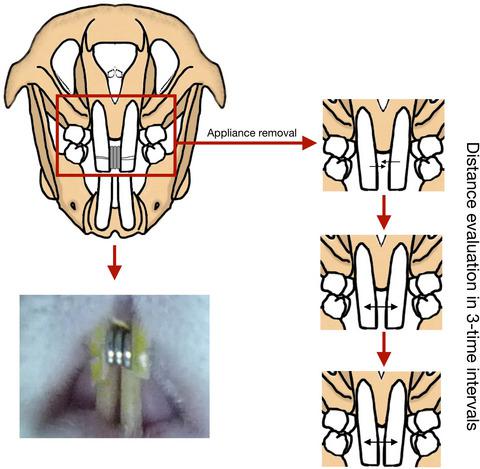当前位置:
X-MOL 学术
›
Photochem. Photobiol.
›
论文详情
Our official English website, www.x-mol.net, welcomes your
feedback! (Note: you will need to create a separate account there.)
Effect of Photobiomodulation on Relapse in an Experimental Rapid Maxillary Expansion (RME) Model in Rat
Photochemistry and Photobiology ( IF 2.6 ) Pub Date : 2020-12-25 , DOI: 10.1111/php.13365 Maryam Pirmoradian 1, 2 , Hannaneh Safiaghdam 3 , Hanieh Nokhbatolfoghahaei 4 , Sajjad Ashnagar 5 , Reza Fekrazad 6, 7
Photochemistry and Photobiology ( IF 2.6 ) Pub Date : 2020-12-25 , DOI: 10.1111/php.13365 Maryam Pirmoradian 1, 2 , Hannaneh Safiaghdam 3 , Hanieh Nokhbatolfoghahaei 4 , Sajjad Ashnagar 5 , Reza Fekrazad 6, 7
Affiliation

|
Rapid maxillary expansion(RME) is performed on transversely-deficient maxilla. As all orthodontic treatments, retention is important in maintaining therapeutic outcomes. Fixed /removable retainers are used post-RME causing hygiene and compliance problems. Given photobiomodulation's positive effects on the quantity & quality of bone regeneration, its effect on post-RME relapse was studied. Thirty Sprague-Dawley rats were randomly divided into: GroupR, non-irradiated-RME-treated(n=12), groupP, irradiated-RME-treated(n=12) and groupC, non-RME-non-irradiated(n=6). A 1.5mm metal ring inserted between maxillary incisors at day 0 & 15 was expanded until 1.5mm space was obtained at day 30. In groupP, Ga-Al-As diode laser (810nm, 100mW, 4J/cm2 , 30secs) was applied on days 0,2,4,6,8,10,12 and 14 as predictor-variable. The relapse was measured as the space lost between incisors for 30 days after appliance removal (primary-outcome-variable) and compared with T-Test. In week 2, space loss in groupP was significantly lower(P<0.05) than all other groups. The relapse during weeks 2&3 was significantly lower in groupP than groupR. However, no significant difference in relapse amount was found between groups during first and fourth week. There was a significant difference(P<0.05) between groups in relapse rates (secondary-outcome-variable) but not in total relapse after 4 weeks. Photobiomodulation proved beneficial in resisting relapse in our study, and it is suggested to be continued until the end of expansion.
中文翻译:

光生物调节对大鼠实验性快速上颌扩张 (RME) 模型复发的影响
在横向缺损的上颌骨上进行快速上颌骨扩张术(RME)。与所有正畸治疗一样,保留对于维持治疗结果很重要。在 RME 后使用固定/可拆卸的保持器会导致卫生和合规性问题。鉴于光生物调节对骨再生数量和质量的积极影响,研究了其对 RME 后复发的影响。将 30 只 Sprague-Dawley 大鼠随机分为:R 组,未照射 RME 治疗(n=12),P 组,照射 RME 治疗(n=12)和 C 组,非 RME 未照射(n= 6)。在第 0 天和第 15 天插入上颌切牙之间的 1.5 毫米金属环被扩大,直到第 30 天获得 1.5 毫米空间。在 P 组中,应用 Ga-Al-As 二极管激光(810nm,100mW,4J/cm2,30 秒)第 0、2、4、6、8、10、12 和 14 天作为预测变量。复发的测量方法是在移除矫治器后 30 天内切牙之间的空间损失(主要结果变量),并与 T 检验进行比较。在第2周,P组的空间损失显着低于其他所有组(P<0.05)。在第 2 周和第 3 周,P 组的复发率明显低于 R 组。然而,在第一周和第四周,两组之间的复发量没有显着差异。组间复发率(次要结果变量)有显着差异(P<0.05),但 4 周后总复发率无显着差异。在我们的研究中,光生物调节被证明有利于抵抗复发,建议持续到扩张结束。P组的空间损失显着低于其他所有组(P<0.05)。在第 2 周和第 3 周,P 组的复发率明显低于 R 组。然而,在第一周和第四周,两组之间的复发量没有显着差异。组间复发率(次要结果变量)有显着差异(P<0.05),但 4 周后总复发率无显着差异。在我们的研究中,光生物调节被证明有利于抵抗复发,建议持续到扩张结束。P组的空间损失显着低于其他所有组(P<0.05)。在第 2 周和第 3 周,P 组的复发率明显低于 R 组。然而,在第一周和第四周,两组之间的复发量没有显着差异。组间复发率(次要结果变量)有显着差异(P<0.05),但 4 周后总复发率无显着差异。在我们的研究中,光生物调节被证明有利于抵抗复发,建议持续到扩张结束。05)组之间的复发率(次要结果变量)但不是 4 周后的总复发率。在我们的研究中,光生物调节被证明有利于抵抗复发,建议持续到扩张结束。05)组之间的复发率(次要结果变量)但不是 4 周后的总复发率。在我们的研究中,光生物调节被证明有利于抵抗复发,建议持续到扩张结束。
更新日期:2020-12-25
中文翻译:

光生物调节对大鼠实验性快速上颌扩张 (RME) 模型复发的影响
在横向缺损的上颌骨上进行快速上颌骨扩张术(RME)。与所有正畸治疗一样,保留对于维持治疗结果很重要。在 RME 后使用固定/可拆卸的保持器会导致卫生和合规性问题。鉴于光生物调节对骨再生数量和质量的积极影响,研究了其对 RME 后复发的影响。将 30 只 Sprague-Dawley 大鼠随机分为:R 组,未照射 RME 治疗(n=12),P 组,照射 RME 治疗(n=12)和 C 组,非 RME 未照射(n= 6)。在第 0 天和第 15 天插入上颌切牙之间的 1.5 毫米金属环被扩大,直到第 30 天获得 1.5 毫米空间。在 P 组中,应用 Ga-Al-As 二极管激光(810nm,100mW,4J/cm2,30 秒)第 0、2、4、6、8、10、12 和 14 天作为预测变量。复发的测量方法是在移除矫治器后 30 天内切牙之间的空间损失(主要结果变量),并与 T 检验进行比较。在第2周,P组的空间损失显着低于其他所有组(P<0.05)。在第 2 周和第 3 周,P 组的复发率明显低于 R 组。然而,在第一周和第四周,两组之间的复发量没有显着差异。组间复发率(次要结果变量)有显着差异(P<0.05),但 4 周后总复发率无显着差异。在我们的研究中,光生物调节被证明有利于抵抗复发,建议持续到扩张结束。P组的空间损失显着低于其他所有组(P<0.05)。在第 2 周和第 3 周,P 组的复发率明显低于 R 组。然而,在第一周和第四周,两组之间的复发量没有显着差异。组间复发率(次要结果变量)有显着差异(P<0.05),但 4 周后总复发率无显着差异。在我们的研究中,光生物调节被证明有利于抵抗复发,建议持续到扩张结束。P组的空间损失显着低于其他所有组(P<0.05)。在第 2 周和第 3 周,P 组的复发率明显低于 R 组。然而,在第一周和第四周,两组之间的复发量没有显着差异。组间复发率(次要结果变量)有显着差异(P<0.05),但 4 周后总复发率无显着差异。在我们的研究中,光生物调节被证明有利于抵抗复发,建议持续到扩张结束。05)组之间的复发率(次要结果变量)但不是 4 周后的总复发率。在我们的研究中,光生物调节被证明有利于抵抗复发,建议持续到扩张结束。05)组之间的复发率(次要结果变量)但不是 4 周后的总复发率。在我们的研究中,光生物调节被证明有利于抵抗复发,建议持续到扩张结束。











































 京公网安备 11010802027423号
京公网安备 11010802027423号